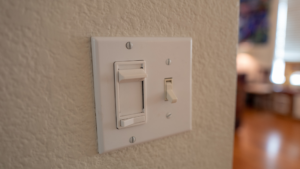
Early Dimmer Switches
Joel Spira invented the dimmer switch in 1959. He realized that by lowering a variable resistor over a circuit, he could restrict the flow of electricity into an electrical device. When he connected the switch to a lightbulb, he was able to control its output. Spira originally marketed his invention as a romantic device that allowed couples to set the mood after the kids went to bed. Unfortunately, his design had a few limitations that affected its popularity.
First, it didn’t lower energy consumption. It simply blocked electricity, so homeowners wound up paying the same for less light. Second, the unused power was absorbed by the circuit, which led to an excess of heat that wore down electrical equipment and created a potential fire hazard.
Modern Dimmer Switches
Rather than impeding electricity, modern dimmer switches come with a TRIAC power control device that turns the unit on and off in quick succession. American homes are powered by alternating current, whose polarity flips rapidly from positive to negative and back again, around sixty times a second.
Every time it flips, the triac device momentarily shuts off the circuit, reducing the amount of energy going into the bulb without making the lights flicker. Adjusting the dimmer determines how long the circuit’s off, which determines how bright your lights are. This prevents heat from building up in the circuit while reducing power consumption at the same time.
Types of Dimmer Switches
Dimmer switches are not a single device. They come in three basic models. Choosing the right one depends on the layout, set-up, and equipment used in your home.
- Single Pole. The simplest dimmer and the most common: a single light is controlled by a single switch.
- Three-Way Dimmers. Instead of a single dimmer, the light is controlled by two or more switches in separate parts of the room.
- Multi-Location Dimmers. With this setup, the light is controlled by multiple dimmers installed in different parts of your house.
There is also a fourth type of dimmer that isn’t wired into your electrical system but plugs into the wall, normally used to control floor and table lamps. Besides their set-up, dimmers are also categorized by their operation. Forward-phase dimmers shut down the circuit when the alternating current is in the middle of its cycle, as the electron is losing its charge. By contrast, reverse-phase dimmers shut down at the beginning of the cycle, as the electron is gaining its charge.
Incandescent light bulbs and Light Emitting Diodes (LEDs) can be controlled by both forward-phase and reverse-phase dimmers. On the other hand, an MLV (Magnetic Low Voltage) bulb can only be controlled by a forward-phase dimmer and an ELV (Electric Low Voltage) bulb can only be controlled by a reverse-phase dimmer. MLV bulbs are generally used in recessed lighting, while ELV bulbs are normally used as work lights or under-cabinet lighting.
If you don’t know which lights you have in your home, install a universal dimmer switch, which lets you adjust all of them. Besides a TRIAC, they’re also equipped with microcontrollers, which detect the type of bulb they’re connected to, so they can change from forward-phase to reverse-phase as needed.
Save on Electrical Repairs with Agway
Dimmer switches depend on a reliable electrical system. Protect your internal wiring with Agway’s EnergyGuardTM program. It covers your heating, cooling, and electrical systems* from damage caused by wear and tear. Repairing home wiring can cost hundreds of dollars, and without protection, homeowners have to shoulder the cost.
Home insurance won’t protect you against this type of damage, but EnergyGuardTM will. When the need for repair occurs, Agway customers don’t waste time searching for a qualified technician. Our service team has an extensive network of local contractors, so we can schedule repairs right away. There are no service fees or deductibles either. We pay for the visit and all covered parts. Sign up and start enjoying the benefits of EnergyGuardTM today!